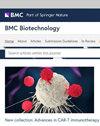Ferula latisecta gels for synthesis of zinc/silver binary nanoparticles: antibacterial effects against gram-negative and gram-positive bacteria and physicochemical characteristics
IF 3.4
3区 生物学
Q2 BIOTECHNOLOGY & APPLIED MICROBIOLOGY
引用次数: 0
Abstract
This study explores the potential antibacterial applications of zinc oxide nanoparticles (ZnO NPs) enhanced with silver (Ag) using plant gel (ZnO-AgO NPs). The problem addressed is the increasing prevalence of pathogenic bacteria and the need for new, effective antimicrobial agents. ZnO NPs possess distinctive physicochemical properties that enable them to selectively target bacterial cells. Their small size and high surface area-to-volume ratio allow efficient cellular uptake and interaction with bacterial cells. In this study, the average size of the synthesized ZnO-Ag nanoparticles was 77.1 nm, with a significant standard deviation of 33.7 nm, indicating a wide size distribution. The nanoparticles demonstrated remarkable antibacterial efficacy against gram-negative and gram-positive bacteria, with inhibition zones of 14.33 mm for E. coli and 15.66 mm for B. subtilis at a concentration of 300 µg/ml. Minimum inhibitory concentrations (MIC) were determined to be 100 µg/ml for E. coli and 75 µg/ml for S. saprophyticus. Additionally, ZnO-Ag NPs exhibited excellent biocompatibility, making them appropriate for various pharmacological uses. This study utilizes Ferula latisecta gels, offering a sustainable and eco-friendly approach to nanoparticle synthesis. Incorporating of Ag into ZnO NPs significantly enhances their antimicrobial properties, with the combined results showing great inhibition effects on pathogenic microbes. The findings suggest that ZnO-Ag NPs could be a promising candidate for addressing the challenges posed by drug-resistant bacterial infections and enhancing antimicrobial treatments.用于合成锌/银二元纳米粒子的阿魏凝胶:对革兰氏阴性菌和革兰氏阳性菌的抗菌效果及理化特性
本研究探讨了利用植物凝胶(ZnO-AgO NPs)增强银(Ag)的氧化锌纳米粒子(ZnO NPs)的潜在抗菌应用。所要解决的问题是病原菌的日益流行以及对新型有效抗菌剂的需求。氧化锌氮氧化物具有独特的物理化学特性,能够选择性地靶向细菌细胞。它们的尺寸小、表面积与体积比高,能被细胞有效吸收并与细菌细胞相互作用。在这项研究中,合成的 ZnO-Ag 纳米粒子的平均尺寸为 77.1 nm,标准偏差为 33.7 nm,表明其尺寸分布较广。纳米粒子对革兰氏阴性菌和革兰氏阳性菌具有显著的抗菌效果,在浓度为 300 µg/ml 时,对大肠杆菌和枯草杆菌的抑菌区分别为 14.33 mm 和 15.66 mm。对大肠杆菌的最小抑菌浓度(MIC)为 100 微克/毫升,对沙门氏菌的最小抑菌浓度(MIC)为 75 微克/毫升。此外,ZnO-Ag NPs 还具有良好的生物相容性,因此适合用于各种药理用途。这项研究利用了Ferula latisecta凝胶,为纳米粒子合成提供了一种可持续的环保方法。在 ZnO NPs 中加入 Ag 可显著增强其抗菌性能,综合结果显示对病原微生物有很好的抑制作用。研究结果表明,ZnO-Ag NPs 有望成为应对耐药细菌感染挑战和加强抗菌治疗的候选材料。
本文章由计算机程序翻译,如有差异,请以英文原文为准。
求助全文
约1分钟内获得全文
求助全文
来源期刊

BMC Biotechnology
工程技术-生物工程与应用微生物
CiteScore
6.60
自引率
0.00%
发文量
34
审稿时长
2 months
期刊介绍:
BMC Biotechnology is an open access, peer-reviewed journal that considers articles on the manipulation of biological macromolecules or organisms for use in experimental procedures, cellular and tissue engineering or in the pharmaceutical, agricultural biotechnology and allied industries.
 求助内容:
求助内容: 应助结果提醒方式:
应助结果提醒方式:


